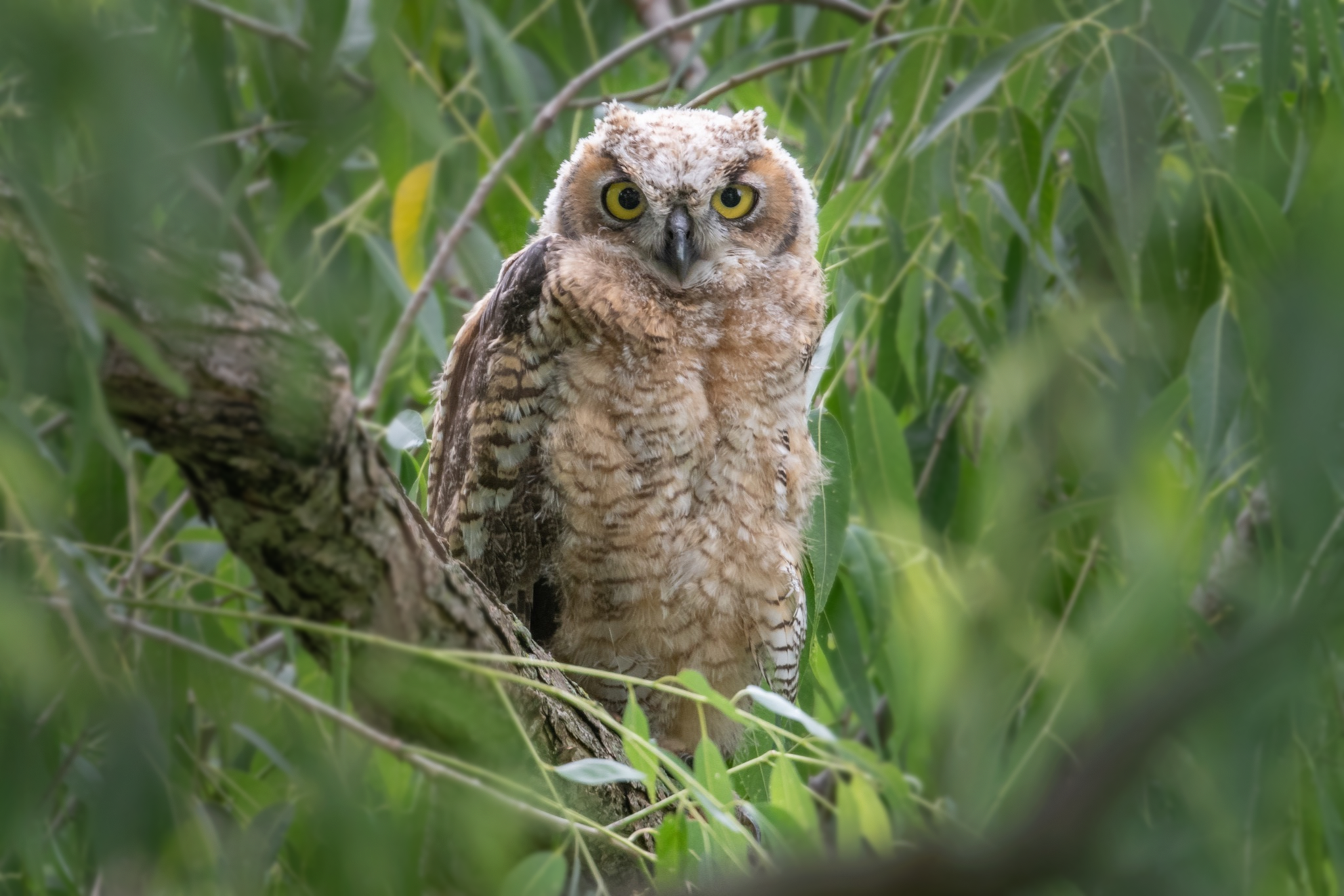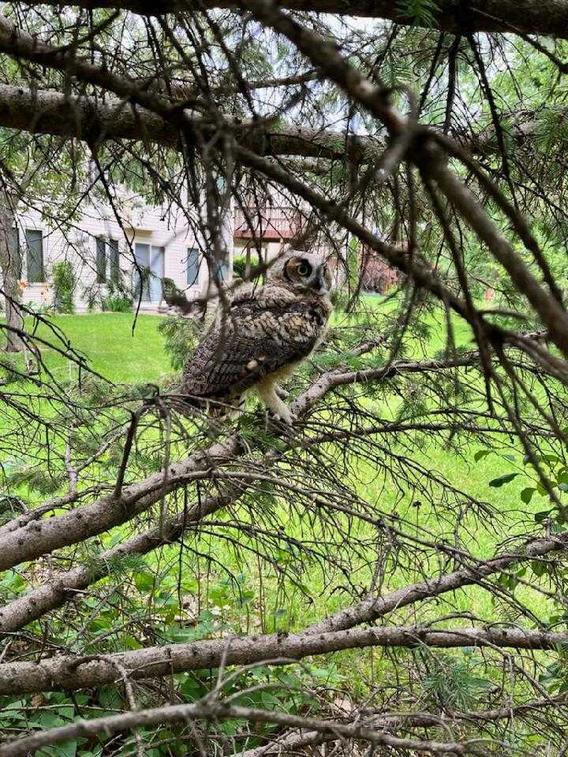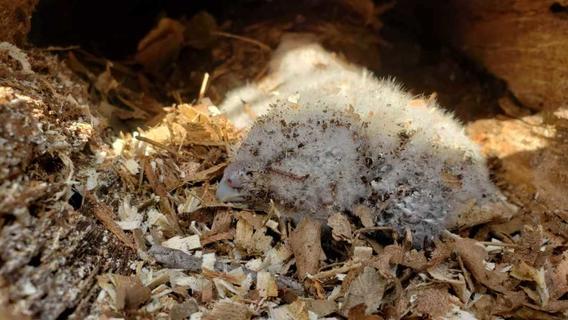
Perched on a branch, eyes searching the foliage and ears at the ready, a young great horned owl calls for its parents. The sound is answered, not by the owlet’s biological parents but by another pair of owls with two chicks of their own.
As the days pass, it’s clear the family is receptive to adding another to their brood, and the young bird is cared for by the foster parents, much to the relief of the human observers keeping an eye on the baby’s progress. It’s a happy ending to a story that repeats itself each year as young raptors emerge from their eggs into a world full of challenges.
One of those challenges is becoming separated from their parents. In the case of the great horned owlet, it received a second chance at survival with a foster family through an arrangement facilitated by The Raptor Center (TRC) staff and volunteers. TRC fields and responds to hundreds of calls from mid-March to mid-August about young raptors in need of assistance.
Assessing their needs and providing care gives these juvenile raptors a chance to thrive in the wild and has an impact that reaches beyond each individual bird.
Staying healthy
Each year, TRC sees around 150 young raptors come through its doors as patients. Its staff consults on another 75-100 cases in and outside of Minnesota. Not all calls require medical intervention, according to Dr. Dana Franzen-Klein, TRC’s medical director.
“Young raptors are quite resilient—sometimes they fall from their nest with no significant injuries at all,” she says. “They just need some help to get back up to safety.”
Those admitted to the center’s clinic receive medical evaluations and are placed in special areas during their stay that limit human interaction as much as possible. It keeps the young birds from seeing people as parents and bonding with them, which would make them non-releasable.
Caring for juvenile raptors during their stay at TRC is no easy task, and factors such as disease can add another layer of complexity. For example, the widespread outbreak of highly pathogenic avian influenza (HPAI) in the U.S. in early 2022 meant TRC staff needed to employ extra precautions to be sure HPAI-positive patients weren’t spreading the disease to young birds.
Staff members also were incredibly careful to confirm any young raptor returned to the wild was not carrying the disease, especially those placed in foster situations like the great horned owlet.
“We want to make sure that these young animals do not have HPAI because we don’t want to take that bird, place it into a foster nest, and have it spread the virus to other raptors,” says Gail Buhl, partnership coordinator for Partners for Wildlife, a grant-funded program at TRC focused on providing education and resources to wildlife care professionals.
Releasing healthy young raptors back into the wild gives each the chance to mature and become a contributing member of its population. If juvenile raptors are old enough when they come to TRC for care, they also have an opportunity to contribute to research.
We can place a federal band on their leg so that if they are ever encountered again, we can identify that individual and gain information such as about how long it lived and where it moved relative to where we released it,” Franzen-Klein says.
However, assisting juvenile raptors has a larger impact than perpetuating and tracking their species.
Environmental impact
Each raptor that arrives at TRC has a story to tell, and babies are no different. The data staff collect from young patients provide not only a medical history of the bird but give insight into the environmental health of the area where it was found.

“By assisting juvenile raptors in need, we gain more information about what is going on in our local ecosystem based on the reason they come in for care,” Franzen-Klein says. “This allows us to keep an eye on our local ecosystem as a whole.”
Unlike adults, young raptors remain in the nest and aren’t flying miles and miles a day to find food. Adults tend to stay within their territory to hunt for their young, which narrows any sort of interaction with human activity to a defined area. For example, if there are pollutants present in sources of food such as fish, research has found it’s possible to detect trace amounts in juvenile birds.
"Fish are the vacuum cleaners of the water—they’re immersed in it so it ends up in their tissues,” Buhl says. “Say an eagle swoops down and grabs the fish to bring it back to its nest and feed its babies. A low amount of pollutants may not kill the young raptors, but researchers are using the traces they do find in their blood to help determine the human impact on water quality.”
A young raptor’s health also could point to other environmental issues, such as a lack of stable food supply or increased human presence such as construction and logging.
Impact of Outreach
Though human activity can have negative impacts on the environment and raptor habitat, young raptors can have a positive impact of their own on humans.

| Photo courtesy of The Raptor Center
The sight of a young animal alone often prompts people to jump into action and rescue it. TRC staff and volunteers receive calls from people who are unsure of what to do when encountering a baby raptor on its own. Not all baby raptors need rescuing, but their presence provides an opening for outreach and education, according to Buhl.
“It’s not an opening to lecture anybody or to say they’re doing something wrong. They’re trying to learn,” she adds. “Most people have never had anything like this happen to them in their entire lives. They’re gonna be taking pictures, they’re gonna be telling their friends. So we want to make a good experience. Even if the animal does not survive, it can still be a fulfilling experience.”
It’s in these moments that TRC staff hope to effect change by educating people about raptors and their role in the world. Learning more about raptors in turn encourages people to think about the big picture of conservation and recognize that there are many ways they can make a difference.
It might start small with a chance encounter with a baby owl alone in a backyard, but every person who values the natural world around them has an opportunity to make a big impact one act at a time.